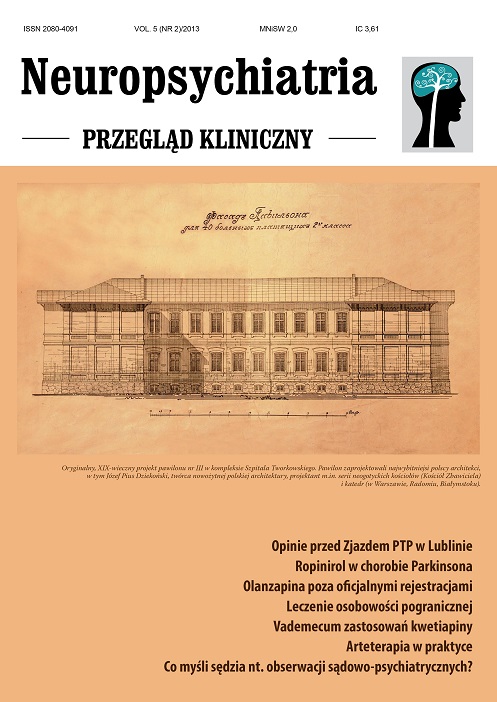Art therapy in the world of depression (II phase) Review article
Main Article Content
Abstract
The purpose of these studies is to stimulate patients with depression to art therapeutic activity. We analyze the 2nd phase of studies on art therapy in psychiatry. The 1st phase was presented in “Neuropsychiatry. Clinical Review”, vol. 3 (No 3) 2011. At the current stage, arttherapeutic activities are applied in open space. Such forms of creative activity as workshops, performance, and installation are undertaken. Previous activities of cognitive, emotional, and behavioral nature are continued. In case studies, the process of creating art is described based on the diagnosis, record of observations of the arttherapeutic session. Patient’s statements expressed before, during, and after the session are also quoted. A comparison of the 1st and 2nd phases of art therapy is done based on subjective scales, i.e., descriptive scales that rely on those used in fine arts. These scales, according to a general idea of the project: „From art activity to rehabilitation of one’s own competences”, will complement a psychometric research (PGWB and HADS scales) (3rd phase of studies).
Article Details

This work is licensed under a Creative Commons Attribution-NonCommercial-NoDerivatives 4.0 International License.
Copyright: © Medical Education sp. z o.o. License allowing third parties to copy and redistribute the material in any medium or format and to remix, transform, and build upon the material, provided the original work is properly cited and states its license.
Address reprint requests to: Medical Education, Marcin Kuźma (marcin.kuzma@mededu.pl)
References
2. Rudowski T. Studia nad arteterapią w ujęciu aksjologiczno-psychologicznym. Wydawnictwo Uniwersytetu Warszawskiego; Warszawa 2009.
3. Kaduson H, Schafer Ch. Zabawa w psychoterapii. Wyd. GWP; Gdańsk 2003.
4. Art as Therapy: Collected Papers. Gerity L (red.). Jessica Kingsley; London 2000.
5. Bednarski P, Łoza B, Pałuba M, Zielińska A. Nowe środki wyrazu w arteterapii: instalacja, happening, performance. Psychiatria Polska 2010; XLIV, 3 (suplement): 105-106.
6. Bednarski P, Patejuk-Mazurek I, Polikowska M, Łoza B. Funkcje poznawcze: czym są i jak je mierzyć? Neuropsychiatria. Przegląd Kliniczny 2011; 3.
7. Chmielnicka-Plaskota A. Metoda projektu w edukacji i arteterapii. Akademia Pedagogiki Specjalnej; Warszawa 2010; 81-85.
8. Chmielnicka-Plaskota A. A New Approach to Artetherapy Through Group Based Project. W: Arteterapia jako dyscyplina akademicka w krajach europejskich. Szulc W (red.). Oficyna Wydawnicza ATUT – Wrocławskie Wydawnictwa Oświatowe; Wrocław 2010.
9. Chmielnicka-Plaskota A, Łoza B, Bednarski P., Zielińska A. Arteterapia – leczenie poprzez wartości. Neuropsychiatria. Przegląd Kliniczny 2011; 3: 52-57.
10. Dalley T, Rifkind G, Terry K. Three voices of art therapy: image, client, therapist. Routledge; London 1993.
11. Landgarten HB. Clinical art therapy. Brunner/Mazel; New York 1981.
12. Malchiodi CA. Medical art therapy with adults. Jessica Kingsley; London 1999.
13. McNiff S. Art as medicine: creating a therapy of imagination. Shambhala; Boston 1992.
14. Naumburg M. Dynamically oriented art therapy: Its Principles and Practice. Magnolia; Chicago 1966.
15. Szulc W. Arteterapia jako nauka. W: Chmielnicka-Plaskota A (red.). Aktywność twórcza w edukacji i arteterapii. Tom 1. Akademia Pedagogiki Specjalnej; Warszawa 2010: 40-49.
16. Wadeson H. Art psychotherapy. Wiley; New York 1980.
17. Zielińska A, Bednarski P, Łoza B, Pałuba M. Jaka sztuka leczy? Psychiatria Polska 2010; XLIV (3, suplement): 103-104.

